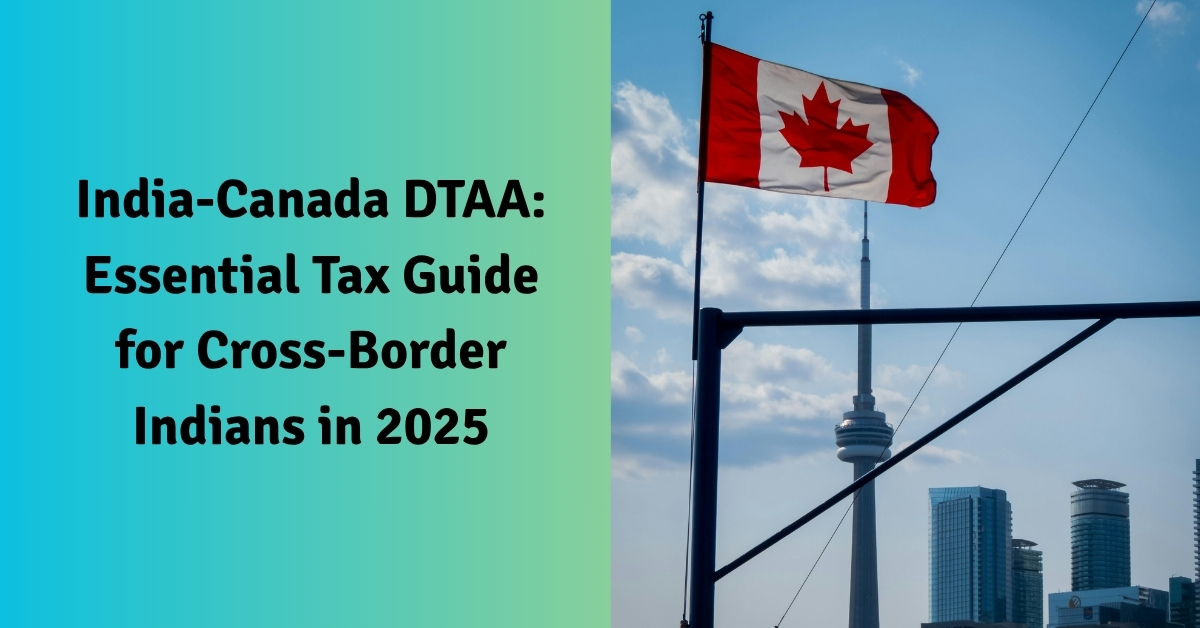India-Canada DTAA: Essential Tax Guide for Cross-Border Indians in 2025

As Canada turned out to be among the most popular destinations for Indian immigrants, professionals, and students alike, knowing about the Double Taxation Avoidance Agreement (DTAA) between the two countries has gained even greater importance. India-Canada DTAA, which was brought into effect on December 6, 1996, and later modified through protocols, creates a mechanism for avoiding double taxation of the same income. For the emerging Indian expatriate community in Canada, this treaty is an important monetary resource that can make a big difference in tax burdens and wealth creation opportunities across borders.
Understanding the Basis of India-Canada DTAA
India-Canada DTAA exempts double taxation for citizens and enterprises with economic interests in both nations. The extensive agreement addresses multiple types of income and sets precise rules on which nation has the main right to tax particular sources of income. In addition to preventing double taxation, the agreement also seeks to:
- Promote economic cooperation between Canada and India
- Avoid fiscal evasion through information exchange measures
- Establish certainty in cross-border tax treatment
- Lower withholding tax rates on cross-border payments
For Canadians resident in India or Indians with Canadian sources of income, the treaty is an essential planning vehicle, which could save thousands of dollars in unnecessary taxes every year.
Key Income Categories and Their Treatment
Employment Income
For employment income of NRIs working in Canada, the income is mainly taxable in Canada. But where a person earns income in India during the fiscal year, the income would be taxable in India also with some conditions.
The treaty stipulates that the employment income shall remain taxable only in Canada when:
- The recipient remains in India for not more than 183 days in the fiscal year pertinent thereto
- The employer is not an Indian resident
- The remuneration is not borne by a permanent establishment in India
This provision is particularly valuable for Canadian employees temporarily assigned to Indian projects or operations.
Interest Income
Under Article 11 of the DTAA, interest accruing in one nation and remitted to a resident of the other nation may be taxed in both nations. Nevertheless, the tax charged by the country of source is capped at 15% of the gross amount of interest, a lot less than the normal 30% withholding tax in India for non-residents without DTAA relief.
For NRIs holding fixed deposits or savings accounts in India, this lower rate works to save them a considerable amount of tax. Likewise, Canadian citizens who earn interest from their Indian investments also gain from this provision.
Dividend Income
Article 10 refers to dividend income, which is taxable in both jurisdictions. The tax in the source country, though, is limited to 25% of the gross amount of dividends for portfolio investments. Where the beneficial owner is a corporation holding at least 10% of the voting power in the company from which dividends are received, the withholding tax is limited to 15%.
This stratified strategy promotes institutional investment with continued advantages for individual investors with limited holdings.
Capital Gains
Taxation of capital gains under the India-Canada DTAA maintains the general principle that gains from alienation of immovable property can be taxed in the state where the property is located. For other assets of capital, the resident state normally has the right of taxation.
Nevertheless, the treaty has certain provisions for shares whose value is primarily from immovable property, where the state where the property exists can tax gains made from such shares.
Royalties and Fees for Technical Services
Subject to Article 12, royalties and technical services fees derived in a Contracting State and paid to a resident of the other Contracting State may be subjected to taxation by both Contracting States. The tax imposed by the source Contracting State shall not exceed 15% of the gross amount if the beneficial owner is the recipient.
This rule applies especially to technology experts, consultants, and businesses offering cross-border services between Canada and India.
Recent Events Affecting the DTAA in 2025
India-Canada tax environment has experienced a major change in 2025, with multiple developments influencing cross-border taxpayers:
- Digital Tax Factors: With both nations introducing digital services tax interventions, the meaning of the DTAA for technology services provided remotely has become more relevant.
- Pension Portability: More favorable arrangements for recognition of pensions between the two nations have provided greater flexibility in retirement planning for individuals who have worked in both countries.
- Increased Information Exchange: Automatic exchange of information has increased, making compliance more important than ever before for individuals with undeclared assets.
- MLI Effect: The Multilateral Instrument (MLI) has amended some DTAA provisions to avoid treaty misuse and base erosion operations.
- Changes to Residency Determinations: The new work-from-anywhere policies have made tax residency determinations more complex, rendering tie-breaker rules more applicable.
Strategic Tax Planning for Indians in Canada
Residency Rules Navigation
Tax residency determination is the bedrock for the correct application of DTAA benefits. Canadian tax law typically regards you as a resident where you establish strong residential ties to Canada. India’s residence rules are based on physical presence (182 days or more during a financial year).
DTAA has “tie-breaker” provisions for the individual who can be deemed resident in both nations:
- Availability of permanent home
- Place of vital interests
- Habitual residence
- Nationality
Strategic alignment over these aspects can optimize your tax situation over both the jurisdictions.
Documentation Requirements to Claim the Benefits
In order to claim DTAA benefits successfully, adequate documentation is the key:
- Tax Residency Certificate (TRC): Canadian residents need to obtain this from the Canada Revenue Agency to claim benefits in India. This document establishes your tax residence in Canada.
- Form 10F: Required by Indian tax authorities, this form provides additional information about your foreign tax status.
- PAN Card: A Permanent Account Number is mandatory for claiming DTAA benefits in India, even for non-residents.
- NR73 Determination: In certain complicated cases, acquiring a formal residency determination from Canadian authorities may bring assurance.
Structuring Investment to the Best Advantage
The DTAA presents possibilities for strategic investment structuring:
- Interest Income Structuring: Due to the 15% limit on interest taxation at source, structuring savings to take advantage of this lower rate can be advantageous.
- Corporate Holdings: The reduced withholding tax rate on substantial corporate shareholdings (15% compared to 25%) could render investing through corporations preferable in certain situations.
- Real Estate Considerations: Familiarity with the provisions for capital gains on property investments in both nations can inform best structures of ownership.
Leveraging Foreign Tax Credits
One of the key ways for relief under the DTAA is through the system of foreign tax credits:
- Foreign tax credits for taxes paid in India are available in Canada, avoiding double taxation.
- Likewise, India offers relief under Section 90/91 of the Income Tax Act.
- Appropriate timing and documentation of foreign tax payments make the most credit available.
Special Considerations for Business Owners
For business owners and entrepreneurs with operations in both countries, a number of DTAA provisions warrant consideration:
- Permanent Establishment (PE): It is important to grasp what a PE is because it has implications for taxing business profits.
- Transfer Pricing: Cross-border related-party transactions need to meet arm’s length standards.
- Service Arrangements: Having service contracts properly structured to maximise treatment under the technical services rules can provide tax savings.
Pitfalls to Avoid
Even with the DTAA, there are various pitfalls that can catch careless taxpayers:
- Misinterpreting Tax Credits: Pre-supposing dollar-for-dollar credits without appreciating limitations can result in surprise tax payments.
- Overlooking Filing Requirements: The DTAA avoids double taxation but doesn’t obviate filing requirements either in one country or the other.
- Incorrect Characterization of Income: Inaccurate characterization of income types may involve invoking the wrong DTAA provisions.
- Timing Mismatches: Varying tax years (April-March in India vs. January-December in Canada) may complicate credit claims.
Conclusion
The India-Canada DTAA presents important tax planning strategies to cross-border taxpayers, but its provisions need to be analyzed with caution and planned for strategically. As the economic interaction between these countries deepens further, and as work goes digital and alters conventional patterns of employment, keeping abreast of DTAA provisions and amendments becomes essential.
Consulting tax professionals who are well versed in both Indian and Canadian taxation is strongly advised to create a customized cross-border tax plan. With the right planning, the India-Canada DTAA can become a useful tool in maximizing your international tax situation and accumulating wealth across borders.
FAQs
1. What is the withholding tax rate on dividends under the India-Canada DTAA?
Ans- The withholding tax rate is 25% for portfolio investments, but reduced to 15% if the beneficial owner is a company directly owning at least 10% of the voting power.
2. Do I need to file tax returns in both India and Canada despite the DTAA?
Ans- Yes. The DTAA prevents double taxation but doesn’t eliminate filing obligations in either country.
3. How is rental income from property in India taxed if I’m a Canadian resident?
Ans- Rental income from Indian property is taxable in India, but you can claim a foreign tax credit in Canada to offset the Indian tax paid.
4. Can I claim DTAA benefits on my Canadian pension received in India?
Ans- Yes. Pensions are generally taxable in the country of residence, but may also be taxed in the source country at a reduced rate of 15%.
5. How does the 183-day rule apply under the India-Canada DTAA?
Ans- If you stay in the source country for less than 183 days in a fiscal year, your employment income remains taxable only in your country of residence, subject to certain additional conditions.
6. What documents do I need to claim DTAA benefits in India as a Canadian resident?
Ans- You need a Tax Residency Certificate from the Canada Revenue Agency, Form 10F, PAN Card, and self-declaration confirming beneficial ownership.
7. Are capital gains from selling shares of Indian companies taxable in Canada?
Ans- Yes, but if the shares derive their value principally from immovable property in India, India may also tax these gains. You can claim foreign tax credits in Canada.
8. How are software development services treated under the India-Canada DTAA?
Ans- They typically qualify as “fees for technical services” under Article 12, with taxation capped at 15% in the source country if you’re the beneficial owner.
9. Does the DTAA prevent the CRA from taxing my undisclosed Indian income?
Ans- No. The DTAA includes provisions for information exchange between tax authorities to combat tax evasion.
10. If I’m physically in Canada but working remotely for an Indian company, where is my income taxed?
Ans- Generally in Canada as your country of residence, but India may also tax a portion if certain conditions are met. You can claim foreign tax credits to avoid double taxation.
Disclaimer: The information provided here is for educational and informational purposes only and should not be construed as financial, legal, or tax advice. Consult with a qualified professional before making any investment decisions. We do not accept any liability for errors or omissions in this information nor any direct, indirect, or consequential losses arising from its use.



